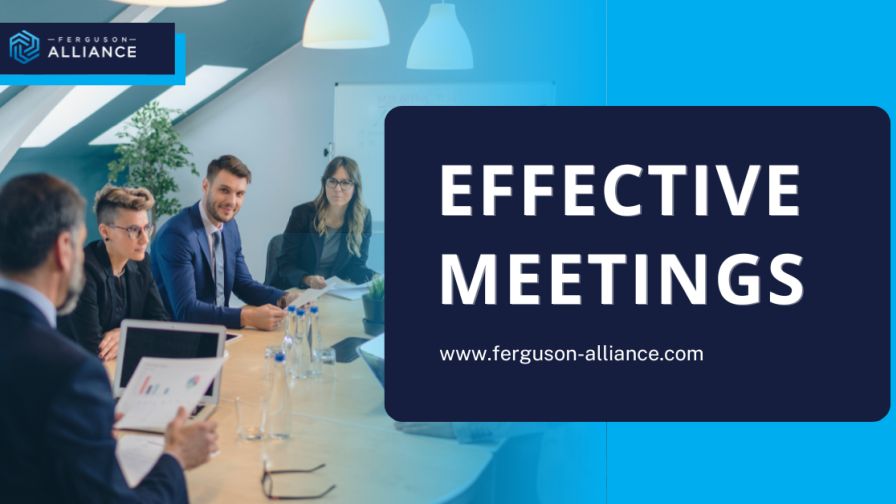
“How to Hold Effective Meetings in Your Family Business” header | Ferguson Alliance
Meetings can be a powerful tool for collaboration, decision-making, and innovation. However, all too often they become onerous tasks with very little to show for the effort. If you want to improve your team’s productivity and keep everyone focused, a good way to do that is to develop some guidelines and best practices around how your organization runs meetings.
From Ferguson Alliance, here’s how you can get a handle on making meetings work for the benefit of your team:
- Prioritize meeting preparation
- Make a meaningful agenda
- Lead with purpose
- Design a reasonable meeting cadence
Let’s take a closer look at how you can put each one of these strategies into practice.
Prioritize Meeting Preparation
When you’re a meeting facilitator, there aren’t any shortcuts when it comes to preparation. You have to put in the work of envisioning how you want the meeting to unfold and what you want to accomplish. And it’s important that you not only prepare yourself for the meeting but that you also prepare other participants.
Anyone attending a meeting should understand its purpose and their role in the discussion so that they can prepare. This means sharing your agenda in advance. There’s not much worse than walking into a meeting having no idea what you’re there to accomplish or how you can contribute – so don’t put your team in that situation. When you share an advance agenda, this also presents an opportunity for members of your team to add their own recommendations for discussion items, which gives them a level of ownership in the process.
Make a Meaningful Agenda
A well-structured agenda is the backbone of a successful meeting.
- Begin by reiterating the meeting’s purpose.
- Clearly state what participants should know, feel confident about, and be ready to act on by the end of the meeting.
- Set a small number of expected outcomes and clearly articulate them.
- Detail meeting topics and allocate specific times for each.
- List meeting participants and their roles.
An effective agenda not only outlines discussion points but also serves as a roadmap to keep the meeting on track and focused on its objectives.
Lead with Purpose
We’ve found that most people believe they attend too many meetings during the workday. However, if a meeting has a clearly defined and articulated purpose, we think you’ll find that your team will be much more enthusiastic about attending – and participating. Therefore, if you can’t clearly define a purpose for your meeting, that may mean you don’t need to have a meeting. And sometimes, it may be OK not to have that meeting.
For example, imagine the recurring team meeting where the same person does most of the talking. Every. Single. Time. Let’s say there are six other team members who attend the meeting, but they don’t participate, letting this one colleague run the discussion. Chances are, this isn’t a very good meeting. For anyone. It may be time to revisit the purpose of it – both with yourself and with your team.
Design a Reasonable Meeting Cadence
Cadence is important when it comes to leading productive meetings, but there are multiple levels of cadence, including:
Frequency
First, there’s the frequency with which you pull team members together..
- Too frequent a cadence and meetings can lose their meaning.
- Too infrequent a cadence can lead projects into trouble because everyone isn’t in the loop.
It’s essential to find a meeting frequency that makes sense for your team and for the types of projects you’re working on.
Time of Day
The time of day is also important. Think about the people on your team and when they’re likely to be most productive.
We’ll go out on a limb and guess that 8 a.m. and 4 p.m. aren’t the best times for meetings. If they can’t be avoided, then so be it, but try to steer clear of them as a rule. Additionally, if you’re asking your team to really participate and be creative, chances are Mondays and Fridays aren’t great days for those types of meetings.
Topics and Timings
Lastly, there’s an important cadence when it comes to leading meetings.
- How much time are you prepared to devote to a particular topic?
- How long will you let the team digress before you rein them back in?
These are important questions to ask yourself before any important meeting where discussion has the potential to go off-course. It may also help your team if you lay out some expectations at the start of the meeting – for example, that some topics may be tabled until a later time in order to make sure the present meeting serves its purpose.
Effective meetings don’t happen by chance – they need deliberate planning, a clear agenda, appropriate timing, and a well-understood purpose.
If you’re a leader within your family business and you’re struggling with meetings that feel lackluster, the power to change things is within your grasp. With some advance preparation, exploration of purpose – and most importantly – some honest conversation with your team, we feel confident you can design a set of best practices that reflect your team’s needs and your obligations to customers.
For additional information and an expanded look at the topic of effective meeting strategies regarding family business, make sure to read the original article on the Ferguson Alliance website.

